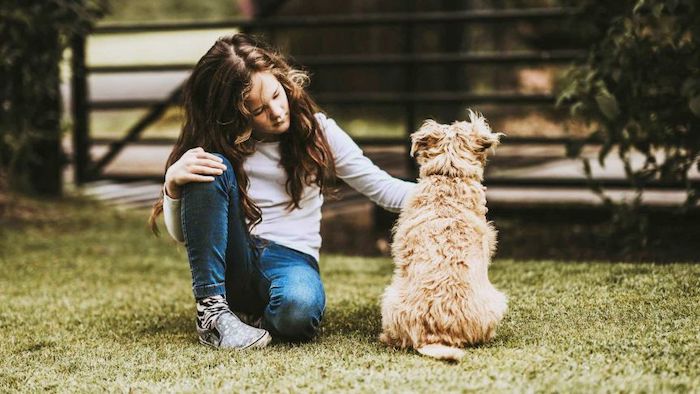— Here’s how to help kids cope, according to experts

For many kids, the death of a pet is their first experience with grief. Here’s how to help them get through it, according to experts.
Many parents aren’t sure how to talk about the death of a pet with their kids. Children often have not experienced death and loss before, and many do not have an understanding of permanency yet. Thankfully, there are some experts in pet loss — and a slew of helpful books — that can help families cope with the death of a beloved pet.
As a veterinarian and mom of four, Dr. Stephanie Nelson has had a lot of experience with losing pets — and with how to talk to kids about it. Her kids, who range in age from 2 to 11 years, are used to having several dogs at a time, and many of those dogs joined their family as adults. “My kids have experienced losing many pets. My kids very much understand that dogs don’t live forever, and we are very open in discussion about the fact that they will see all of their pets die at some point,” says Nelson.
While a pet’s death will always be painful, there are some strategies and tips that can help children navigate their feelings. Here, Nelson and others share how to help kids cope with the loss of a pet, including how to talk about their grief and what to do to help them work through those painful and confusing feelings.
Whether you’re preparing kids to say goodbye to a beloved pet or sharing an unexpected loss, there are a few things to keep in mind as you explain the situation.
Be honest about what’s happening
Some of the language adults use to soften the blow of pet death can be confusing for kids, says Cōlleen O’Brien, a licensed social worker and the founder of BLUE dog Counseling. Phrases like “put to sleep” or “cross the rainbow bridge” make sense to adults because we are used to hearing them. To kids, those phrases are confusing and often scary, says O’Brien.
“Start with fewer details. You can always work up from there based on their questions. Young people are great investigative reporters.”
— Cōlleen O’Brien, licensed social worker
“We say they died or they will die, and that means that they won’t ever be awake or their body won’t be working. And they won’t be here with us,” she offers instead. She says to keep it as simple as possible. “Start with fewer details. You can always work up from there based on their questions,” she adds. “Young people are great investigative reporters.”
Help kids understand the process
Jana DeCristofaro, the community response program coordinator at The Dougy Center: The National Grief Center for Children and Families, says that pet euthanasia in particular may be hard for children to understand. “It’s different than when we talk to kids about a human in our life dying. As adults, you’re often making a decision in collaboration with a vet to help end a pet’s life, and we don’t really do that with humans yet.”
There’s a few simple scripts DeCristofaro says are helpful for parents to use:
- “When our pet can’t get better and is suffering, we need to help end their suffering.”
- “The doctor will give Franklin a medicine, just for animals, and that medicine will let them die peacefully and painlessly.”
DeCristofaro also recommends The Dougy Center’s guide to helping children cope with pet death, created in conjunction with Debra Lee, the veterinary wellbeing director at the DoveLewis Emergency Animal Hospital.
Offer reassurance
Letting children know that euthanasia is a choice due to suffering helps them process the deliberate act of ending a pet’s life. Clarifying that the medication is only for animals can ease fears. It’s important to reiterate that the pet will not feel anything when they pass away.
Helping kids cope with the death of a pet
While some children experience the loss of a human loved one devastatingly early in life, for most children, a pet’s death is their first experience with grief and loss. The skills they use to navigate the loss of the family dog are part of a foundation that will help them handle other losses throughout their lifetime — think of it as a chance to add to their emotional toolkit.
Viewing pet death as a form of grief is actually a relatively new way to look at it, says O’Brien. “Pet loss only started to be acknowledged in the 80s,” she says. “They were going like, ‘Hey, folks, we’ve missed lots of forms of grief.’” The death of a pet can affect kids — and grown-ups — in the same way that losing a human family member can, so it is important to acknowledge how big this may feel to your kids. Here are some expert suggestions to help them work through it.
1. Make room for complex emotions
It’s important to recognize that kids process grief differently at various ages, says O’Brien. “The question I get a lot is, ‘My little one is totally upset, and then the next minute they’re playing with their dolls. Is there something wrong with them that they’re not registering this properly?’” That compartmentalizing of grief is actually very common for young kids, she says. They may grieve for short periods of time and then appear unfazed.
For older kids, tweens and beyond, parents may see more classic signs of grief. “They’re conscious enough to know death is permanent,” says O’Brien, “but they haven’t had a lot of experience with permanency, so they’re grappling with that.” She says tweens and older kids are the age group that often becomes very quiet or even explosively angry at times while grieving.
2. Let kids take the lead
When kids are dealing with grief and loss, all the experts say it’s better to let them take the lead on processing their feelings. Offer basic information and answer follow-up questions. “As a parent you’ve got your kids in front of you, and your biggest priority is their well-being,” says DeCristofaro. “Our biggest instinct is to protect our kids from pain.” That instinct, though, can also prevent them from getting to say goodbye and feel what it means to grieve. If your pet’s death is not sudden and there’s a chance to say goodbye, offer it to your kids. If they say no, do not push.
“I think that it is good to have rituals with kids when they lose a pet. We scatter some of the ashes in that dog’s favorite place.”
— Dr. Stephanie Nelson, veterinarian
3. Create a goodbye ritual to help ease the pain
When one of their dogs is showing signs of aging or a terminal illness, Nelson says they use truthful language to explain what is happening. If they know when the death will happen, they prepare the kids and follow the same rituals each time.
“We spoil the dog beforehand. Every one of our dogs gets a whole Happy Meal that the kids get to feed to them,” she says. They let the kids say goodbye, but do not let them witness euthanasia. The family also keeps photos of beloved dogs on shelves in their house. The kids often stop by to look at them and share a memory or two, which Nelson thinks is helpful for them. “I think that it is good to have rituals with kids when they lose a pet. We scatter some of the ashes in that dog’s favorite place,” she says.
4. Consider censoring certain parts of your pet’s death
Some kids may ask if they can see the pet be euthanized or see them after they die. “Most people do not bring younger kids to a euthanasia and instead choose to say goodbye at home,” says Nelson of young children. Some tweens and teens do ask to come along, and she advises being honest about what they will see. “Some children do not want the last visual of their pet being after it has passed away; it is often easier on them to remember only the pet alive and at home,” she says.
As for viewing ashes or other remains, that is another decision to let the child make once you’ve provided them with all the information. Explain that their pet will not look like they remember — ashes will look like a small pile of bone shards and dust, and a deceased intact pet will be cold and stiff. O’Brien says it is better to wait until the child asks, rather than to offer.
5. Practice bibliotherapy
All of the experts love bibliotherapy, or the art of using books to process emotions. They recommend the following books to help kids deal with the death of a pet:
- “Something Very Sad Happened” by Bonnie Zucker
- “Longfellow And The Deep Hidden Woods” by Richard Wagner
- “Alfie and the Birthday Surprise” by Shirley Hughes
- “Cat Heaven” by Cynthia Ryland
- “The Tenth Good Thing About Barney” by Judith Viorst
- “When a Pet Dies” by Fred Rogers
- “Goodbye Mousie” by Robie H. Harris
- “The Invisible Leash” by Patrice Karst
Nelson adds that for older kids and teens, any book on grief is helpful, even if it’s not pet-specific — kids are able to make those mental connections as they age.
When to get a new pet after a loss
As to when to get a new pet? That’s another great place to let children lead, though it is important to make sure the whole family is on board with adding another animal. Some families find getting a new pet quickly helps kids shift their focus from the loss, while others need more time to feel ready. Both options are normal and acceptable.
Many kids worry their deceased pet will resent a new pet. “We ask, ‘What would your pet think if you gave another pet a loving home and cared for them?’” says O’Brien. “Most kids say, ‘Well, they would want me to do that.’”
The bottom line
Losing a pet is one of the most difficult experiences a family can go through. But, with the right preparation and openness to discuss big feelings, it can also be a foundational moment in a child’s life where they learn how to navigate grief and loss. As you navigate a loss, don’t forget to talk to your veterinarian, too. Many are experienced in helping families navigate pet death and can be a great source of support.
Complete Article ↪HERE↩!

